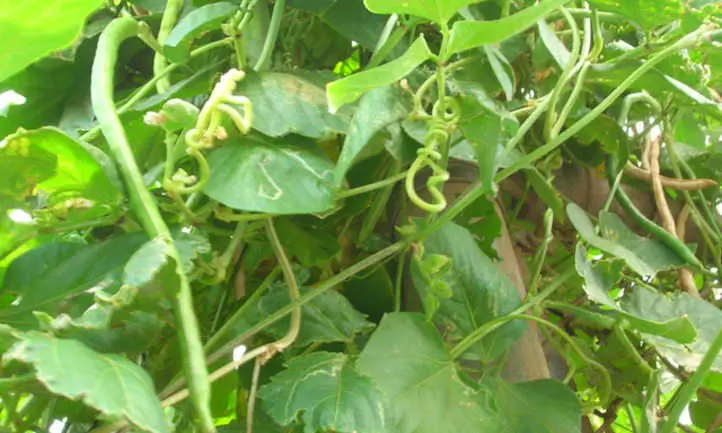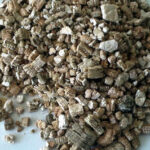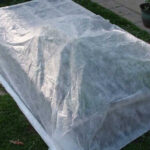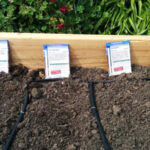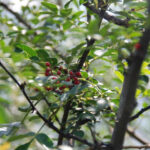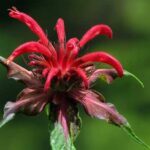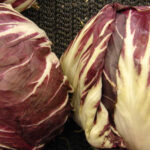Growing a yardlong bean needs to be a part of your garden plans. Named for their size, yardlong beans can grow up to 3 feet long (although the average size is a half-yard). Because they are a vining plant that grows vertically, they’re a great choice for gardeners who don’t have a lot of room. Because of their size and abundance during harvest time, you will likely have yardlong beans to eat throughout the year. Yardlong beans grow well in most climates, making them an excellent choice for a newbie’s garden.
There is a lot that can be done to prepare yardlong beans. These vegetables taste great cooked or raw. They’re the perfect thing to grow for those looking to get creative in the kitchen. Chopped up raw, they are a great addition to salads. Whether sauteeing, grilling, or making stir-fried longbeans, adding a little heat will intensify their flavor. Some prefer the yardlong bean to green beans when a soup or stew calls for them as they don’t get as soggy.
Unlike green beans, yardlong beans are better prepared with oil than water, making them the perfect addition to stir-fried dishes. Yardlong beans can be traced back to parts of Asia and are a common ingredient among Chinese dishes, especially dry-fried green beans with a dash of soy sauce. Some prefer the simpler approach of sauteeing them in garlic and butter. They are a great source of fiber, vitamin C, iron, and vitamin A.
Quick Care Guide
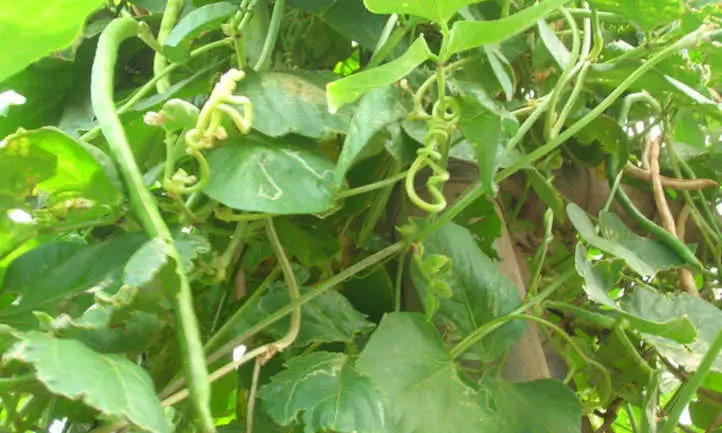
| Common Name(s) | Yardlong bean, asparagus bean, snake bean, Chinese long bean |
| Scientific Name | Vigna unguiculata subsp. sesquipedalis |
| Days to Harvest | 70-90 |
| Light | Full sun |
| Water | 1-2 inches of water per week |
| Soil | Well-draining, loamy soil |
| Fertilizer | Minimal; compost is fine |
| Pests | Aphids, thrips, worms, caterpillars |
| Diseases | Bacterial blight, powdery mildew |
All About The Yardlong Bean
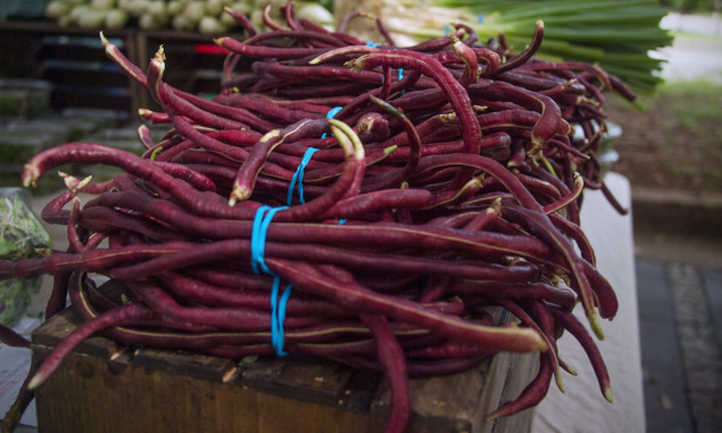
The yardlong bean, also known as Vigna unguiculata subsp. sesquipedalis, is a vine plant grown for its edible pods and is similar to a green bean. Despite their name, yardlong beans are actually a variety of cowpea and are more closely related to peas than beans. They can occasionally grow up to 3 feet long, but it is recommended to harvest them well before they reach that point. Sometimes called Chinese long beans, these originated in southern China and Southeast Asia. Along with the names yardlong bean and Chinese long bean, people also call them snake beans and asparagus beans.
Chinese long beans have climbing vines from which emerge flowers and pods. The flowers can be lavender, pink, or white, depending on the variety. Like most of the legume family, they are great at pulling nitrogen from the air and adding more fertility back to the ground. But most people specifically grow them so they can eat their long pods.
Yardlong beans are generally planted in the spring once the ground is warm. The seeds will emerge in 10 to 14 days, and after about an 80 day growing season, beans can be harvested and eaten, cooked in a stir fry, or stored to eat throughout the year.
Types of Yardlong Beans
There are a couple of different varieties of asparagus beans, and they are all extremely different from each other and the classic asparagus bean.
- Stickless Wonder: This is the only one that produces bush beans of all the yardlong varieties. As a bush bean, this bean doesn’t need any sort of trellis or support, but using a stake to provide reinforcement when it’s windy may be beneficial. It also has a shorter growing season but can pod out much quicker at 55 days.
- Chinese Red Noodle: These Chinese long beans are a beautiful maroon color that stays with them even when cooking. They are primarily chosen for appearance reasons as they have a similar fresh taste to other asparagus beans. This variety takes 80-90 days to reach maturity.
- Liana: An early maturing asparagus bean that grows on long vines. It is a day-neutral plant, meaning it will flower regardless of the amount of daylight it receives. This variety may be a good option for those concerned about meeting the full sunlight needs of most yardlong beans.
Planting Yardlong Beans
Choosing where to grow asparagus beans is essential to the overall success of your crop. Pick a place with plenty of light. Growing yardlong beans in the shade may delay flowering on your plants, thus ensuring fewer beans to harvest. Skip growing beans in the same soil that any legumes grew in the previous year. Crop rotation allows you to use the extra nitrogen they provide to the soil for growing other plant types.
Asparagus beans can grow 8-12 feet tall and will need some sort of vine support or trellis. You may also grow asparagus beans along a fence for support. Whatever you choose to use for support should already be present and firmly in place when planting yardlong bean seeds.
If you plant asparagus beans in containers, make sure the containers are at least 10 inches deep. Make sure that the potting media is not compacted and is easily penetrated, as the roots for your vines can easily reach 10 inches deep. A small amount of compost may also be mixed in before planting.
The best planting time for growing yardlong beans is in the spring after the final frost. The soil temperature needs to be at least 65 degrees to germinate but to grow asparagus beans that are very healthy, they’ll germinate even better at 75 degrees.
Asparagus bean seeds should be sown directly into the soil, as they do not handle transplanting well. Plant seeds 1 inch deep and 3-4 inches apart. Once you’ve finished planting time and your seedlings emerge, thin them to 6-8 inches apart. It is recommended to coat the seeds in a soil inoculant before planting to maximize their nitrogen-boosting capabilities later. Water immediately after planting.
Care

While the Chinese long bean is reasonably easy to grow, asparagus beans do require certain conditions to thrive. Once you have a trellis in place and your bean seeds are planted, it’s time to prepare for proper care.
Sun and Temperature
Growing yardlong beans is easy in warm climates, but they can be grown in cooler temperature areas as well. Before planting seeds, the soil should be at least 65 degrees and the plant does its best growing once outside temperatures consistently hit the 70-80 degree range. Chinese long bean also needs full sun. Decreasing the sun or temperature will result in fewer beans, and those that do grow will have tougher skin and not as good quality of the bean.
The asparagus bean can be grown by anyone in USDA zones 2-9. Pay attention to local temperatures to know if frost blankets are needed to protect against cool weather. If the temperature drops below 50 degrees for long periods of time, you run a risk of damaging your crop, although short bursts of cooler weather are fine. These perform well throughout the summer months, and summer heat doesn’t seem to phase them much as long as they have ample moisture. It is recommended to apply mulch once your plant has been established to keep the soil from drying out quickly.
Water and Humidity
Yardlong beans are fairly drought-tolerant, but going too long without water will make the beans tough and shorter. They prefer a consistent watering schedule.
To grow asparagus beans, they typically need one to two inches of water per week. Water at the base of your plant to prevent disease from spreading. Watering in the morning is best. Use a soaker hose or drip irrigation to keep moisture off the plant’s leaves.
Water the seed of your yardlong beans every other day until they germinate. Once they have germinated, continue to water them 2-3 times a week. Once established, an inch of water per week is adequate, although hot summer days may mean more frequent watering.
Soil
The growing media for Vigna unguiculata subsp. sesquipedalis must be well-draining. It is best to go with loose, aerated, loamy soil. The yardlong bean can tolerate acidic soils but does best when it’s in the 5.5-7.5 pH range.
To boost the fertility of your soil, you can add a slight amount of compost in the spring (2-3 inches worth), but it’s not necessary.
Fertilizing
Usually, fertilizing yardlong beans is optional and mostly unnecessary. Like most legumes, they absorb nitrogen in the air and then fix it in the soil via their roots. They are great soil builders but can be sensitive to over-fertilization with nitrogen. If you decide to use fertilizer, choose one that focuses more on phosphorous and potassium rather than nitrogen. This will provide more flowers, and later a pod with better flavor and texture.
Training
Yardlong beans are pole beans, and they need something to climb on. A trellis is recommended. Make sure it’s in place when you plant your beans so they can find it as they grow and begin climbing.
Yardlong beans will grow the entire length of your poles, so make sure not to make them higher than you can reach, or you will not be able to harvest all of your beans. It is recommended that your support structure be about 7 feet in height. You will still be able to harvest beans grown at the top because they are so long and hang from the vines.
Propagation
Grow asparagus beans from seed. You will have the most success planting directly into the ground, and seedlings emerge very quickly. Transplanting is not recommended as these have sensitive roots, although it can be done if you’re careful. Yard long beans don’t propagate well via other methods.
Harvesting and Storing
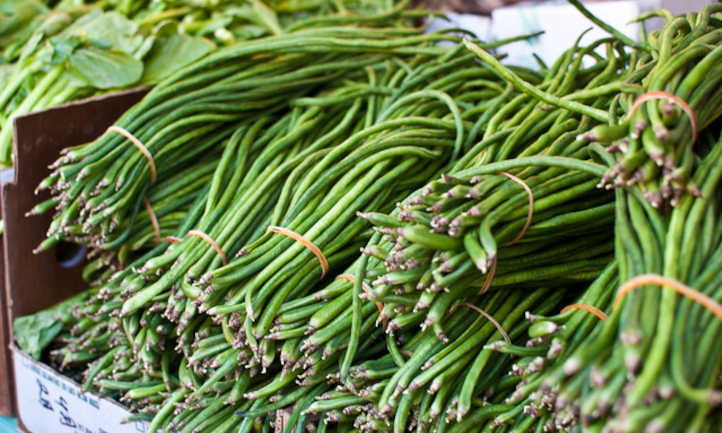
While you may sit around and relax all summer waiting for your beans, harvest season won’t be as relaxing, but it is fun! The yardlong beans grow 1-2 inches per day until they become mature pods. Because of their rapid growth, you will need to harvest daily.
Harvesting
A little over two months after you have planted your asparagus beans, it’s time for harvesting! The beans are ready to pick when they are about as thick as a pencil and about 18 inches long. Despite their name, they rarely reach a yard long; a half yard is average and is much more common than a full yard long bean. The beans should snap when bent. Once picking season begins, you will most likely have to pick beans daily to ensure continuous growth and prolong your season. If a bean is left to ripen on the vine, that plant may stop producing new beans, so it’s important to keep picking your garden regularly!
Growing yardlong beans typically produce at least two beans at a time in each flower cluster. When harvesting, you can hold the plant at the base of the two beans and twist them off, or you can snip the bean off the plant close to the base. Make sure when cutting that you do not cut above the node. Doing so will stop further nodes from forming and halt bean production in that specific location.
If the beans are pale green, yellow, or white, you have waited too long to harvest, and it may be best to leave those plants to produce dried beans for seeds for next year. Harvest your last dry pods before the first frost hits to prevent them from being damaged. You can then remove the seeds from the pods and thoroughly dry them for storage.
The beans are best eaten right after harvesting, but there are a few ways to prepare and store them as well.
Storing
Asparagus beans will last about four days after being picked. To prevent them from developing rusty patches, make sure to keep these vegetables in a moist, cool place. Putting the pods in a baggie with a wet paper towel inside your vegetable crisper with high humidity will give you the best results.
While yardlong beans don’t have the longest shelf life, there are many different ways to prepare and store them so that you can get the most out of your harvest.
A popular option is storing them in the freezer. To do this, you will cut off the ends of the beans, cut them to your desired size, blanch them in boiling water for 30-60 seconds, then strain, pat dry, and bag. If you want to make sure they don’t stick together in the bag, lay them on metal cookie sheets well-separated from one another and freeze them before bagging. Frozen asparagus beans can last up to a year in the freezer without losing flavor.
Canning is also an excellent option for asparagus beans. You can them the same way you would any other green bean or pickle them. Remember, as a low-acid food, your harvested yard long beans will need to be prepared in a pressure canner. Water bath methods are not food-safe and can be dangerous.
Along with canning, they can also be freeze-dried or dehydrated for a healthy snack. You would follow the same instructions in prepping asparagus beans the same way you would any other green bean or other legumes, but can chop up your beans to smaller, more manageable sizes.
Troubleshooting

This beautiful climbing plant does come with its downsides. Fortunately, the problems you might face when growing yardlong beans are common gardening issues, and you most likely are already equipped with the tools you need to handle them.
Pests
There are a few common pests that can impact your yard long beans.
Aphids love beans, and asparagus bean is no exception. They are also susceptible to thrips and spider mites. Luckily, these can all be dealt with similarly. Spray plants early in the day with water to knock them off plants. Regularly spraying neem oil or insecticidal soap will also reduce these bugs in your garden. If you have a severe outbreak, an organic pyrethrin spray is effective as well.
Slugs also love asparagus beans, and getting rid of them is a bit more labor-intensive. The tried and true method of removing them by hand and putting them in a bucket of soapy water is effective, but an organic slug and snail bait may be easier than wandering the garden at night looking for slugs. If not controlled, slugs will eat the leaves down to almost nothing and can chew through the vines.
Some types of caterpillars also love to chew on your beans. These garden annoyances respond extremely well to BT spray treatments. BT, or Bacillus thuringiensis, is a natural bacteria found in soil that will cause caterpillars to stop feeding and eventually starve them to death.
Diseases
If you start seeing white, powdery spots on the stems of your asparagus bean plants, chances are you have powdery mildew. While this is annoying, it is not the end of the world; this white mildew is a very common plant disease. It’s caused by a fungus, and so an antifungal treatment like neem oil is a good starting point. For more severe outbreaks, you can try a copper-based fungicide. Remove the most severely mildew-damaged leaves, throwing them away. Don’t compost material that’s infected to avoid spreading the spores to your compost bin.
You can tell if your asparagus beans have developed bacterial blight if the pods have brown spots and wilted foliage (a yellow halo often surrounds the brown spots). Blight occurs during damp and cool temperatures and often can be spread via aphids or other pests. Avoid overwatering your plants to reduce the humidity around them during cool weather, and keep bugs away from your garden to reduce the risk to your vines.
If you find that your plant has blight, we recommend using a copper fungicide or a sulfur fungicide. Neem oil can also help prevent blight and deter aphids, spider mites, and other pests. With it’s various benefits, if you are growing asparagus beans, some type of neem oil should be in your arsenal.
Frequently Asked Questions

Q: What do yardlong beans taste like?
A: Yardlong beans taste similar to green beans but are a little more grassy. They aren’t as sweet as a green bean either, and some say they have a slightly acidic taste. When you cook them, they develop a more firm and chewy texture, along with a nutty taste.
Q: Can you eat yardlong beans raw?
A: Yes! Yardlong beans can be eaten raw or cooked.
Q: Where do yardlong beans grow?
A: Yardlong beans can grow in most parts of the US. They need three months of sunny, warm temperatures (65-75 degrees) and places where they can get sun all day.

